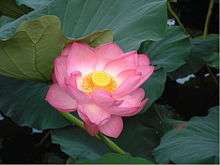Flower Sermon
| Part of a series on |
| Zen Buddhism |
|---|
 |
|
Persons Chán in China
Zen in Japan Seon in Korea Zen in the USA Category: Zen Buddhists |
|
Awakening |
|
Practice |
|
Related schools |

The Flower Sermon is a story of the origin of Zen Buddhism in which Śākyamuni Buddha (Siddhartha Gautama) transmits direct prajñā (wisdom) to the disciple Mahākāśyapa. In the original Chinese, the story is Niān huá wéi xiào (拈華微笑, literally "Pick up flower, subtle smile").
Content
In the story, Śākyamuni gives a wordless sermon to his disciples (sangha) by holding up a white flower. No one in the audience understands the Flower Sermon except Mahākāśyapa, who smiles. Within Zen, the Flower Sermon communicates the ineffable nature of tathātā (suchness) and Mahākāśyapa's smile signifies the direct transmission of wisdom without words. Śākyamuni affirmed this by saying:
I possess the true Dharma eye, the marvelous mind of Nirvana, the true form of the formless, the subtle [D]harma [G]ate that does not rest on words or letters but is a special transmission outside of the scriptures. This I entrust to Mahākāśyapa.[1]
History
The story of the Flower Sermon appears to have been created by Chinese Chán Buddhists.[2] The earliest known version of the tale appeared in 1036.[2]
See also
Notes
References
- Welter, Albert. 2000. Mahākāśyapa’s Smile: Silent Transmission and the Kung-an (Kōan) Tradition. In The Kōan: Texts and Contexts in Zen Buddhism, edited by Steven Heine & Dale S. Wright. Oxford and New York: Oxford University Press, pp. 75–109.